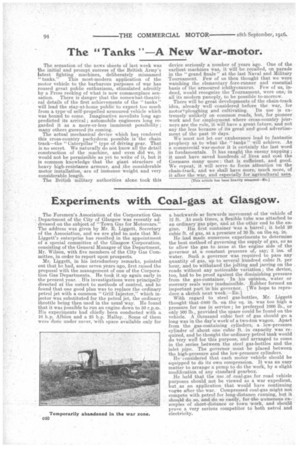Experiments with Coal-gas at Glasgow.
Page 12

If you've noticed an error in this article please click here to report it so we can fix it.
The Foremen's Association of the Corporation Gas Department of the City of Glasgow was recently addressed on the subject of "Town Gas for Motorcars." The address was given by Mr. R. Liggett, Secretary of the Association, and we are glad to. note that Mr. Liggett's enterprise has resulted in the appointment of a special committee of the Glasgow Corporation, consisting of the General Manager of the Department, Mr. Wilson, with five members of the City Gas Committee, in order to report upon prospects. Mr. Liggett, in his introductory remarks, pointed out that he had some seven years ago, first raised the proposal with the management of one of the Corporation Gas Departments. He took it .up again early in the present year. . His investigations were principally directed at the outset to methods of control, and he found that one good plan was to replace the ordinary petrol jet with a common "Grill Injector," which injector was substituted for the petrol jet, the ordinary throttle being then used in the usual -way. He found that it was possible to run an engine down to 50 r.p.m. Bs experiments had chiefly been conducted with a 16 h.p. Albion and a 25 h.p. Halley._ Some of them were clone under cover, avith space available only for a backwards or forwards movement of the vehicle of 12 ft. At such times, a flexible tube was attached to an ordinary gas pipe, and at the other end to the engine. His first container was a barrel ; it held 20 cubit ft. of gas, at a, pressure of 30 lb. on the sq. in. He had made numerous experiments to determine the best method of governing the supply of gas, so as to allow the gas to issue at the engine side of the governor at a constant pressure of, say; 3 ins, of water. Such a governor was required to pass any quantity of gas, up to several -hundred cubic ft. per hour, and to withstand the jolting and jarring on the . roads without any noticeable variation; the device, too, had to be proof against the diminishing pressure from the gas-container. In his opinion, water or mercury seals were inadmissible. Rubber formed an important part in his governor. [We hope to reproduce a sketch next week.—En.] With regard to steel gas-bottles, Mr. Liggett thought that -1800 lb. on the sq. in. was too high a pressure for use in -service ; he preferred 1000 lb., or only 300 lb., provided the space could be found on the vehicle. A thousand cubic feet of gas should go a long was in the day's work of a two-ton wagon. Apart from the gas-containing cylinders, a low-pressure cylinder of about one cubic ft. in capacity was required, and he thought the ordinary petrol tank would do very well for this purpose, and arranged to come in the series between the steel gas-bottles and the inlet pipe. The governor must be placed between the high-pressure and the low-pressure cylinders.
Heconsidered that each motor vehicle should be equipped to do its own compression. It was an easy matter to arrange a pump to do the work, by a slight modification of any standard gearbox.
He held that theuse of coal-gas for road vehicle purposes should not be viewed as a war expedient, but as an application that would have continuing vogue after the war. Compressed coal-gas might not compete with petrol for long-distance running, but it should do so, and do so easily,. for the numerous examples of short-distance or town work, and should prove a very serious competitor to both petrol and electricity.






















